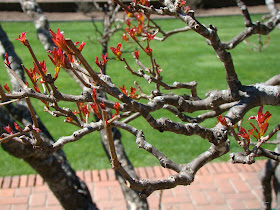 My mother, Betty, was an incredibly creative person and a talented artist. Like most wives and mothers in the 40's/50's, she did not pursue a career outside the home but used her creativity to make clothes, decorate our home, and volunteer to be the artist/craft leader for all groups. Both my sister and I were in awe of her abilities but instead of intimidating us, she encourage us and supplied the materials and opportunities to follow her. This quilt is dedicated to her.
My mother, Betty, was an incredibly creative person and a talented artist. Like most wives and mothers in the 40's/50's, she did not pursue a career outside the home but used her creativity to make clothes, decorate our home, and volunteer to be the artist/craft leader for all groups. Both my sister and I were in awe of her abilities but instead of intimidating us, she encourage us and supplied the materials and opportunities to follow her. This quilt is dedicated to her. Most of the fabrics for this quilt came from her scraps. It contains memories of clothes she made for herself, my sister and I, and her granddaughters.
Most of the fabrics for this quilt came from her scraps. It contains memories of clothes she made for herself, my sister and I, and her granddaughters. As I commented to Jackie, I didn't follow the conventional technique for grandmother's garden because I didn't know any better. As I cut the hexagons, I marked each corner with pencil. Matching these dots, I joined the seams with alternating running stitch and backstitch. I really found this less time and work intensive because I didn't cut paper templates, press under the seam allowance or baste. Maybe it wasn't the "right" way but it worked.
As I commented to Jackie, I didn't follow the conventional technique for grandmother's garden because I didn't know any better. As I cut the hexagons, I marked each corner with pencil. Matching these dots, I joined the seams with alternating running stitch and backstitch. I really found this less time and work intensive because I didn't cut paper templates, press under the seam allowance or baste. Maybe it wasn't the "right" way but it worked. I hand quilted this queen size bed topper. The whole process took about 2 years with other projects in between. As of yet I have no granddaughters to pass on this heirloom so if my oldest son doesn't have any girls, it will go to our first granddaughter-in-law.
I hand quilted this queen size bed topper. The whole process took about 2 years with other projects in between. As of yet I have no granddaughters to pass on this heirloom so if my oldest son doesn't have any girls, it will go to our first granddaughter-in-law.














































